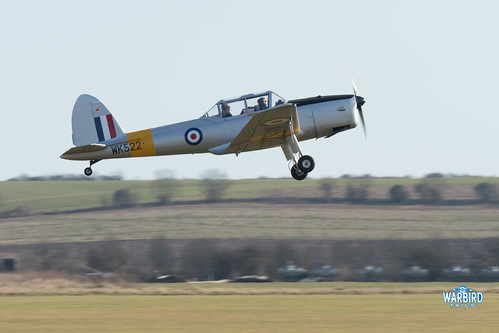The de Havilland Canada Chipmunk is well loved by pilots and considered to be one of the finest flying machines every built. The original Chipmunk design is now over 70 years old, with the type first taking to the skies in May 1946.
The Chipmunk was designed, developed and initially manufactured in Canada with the main purpose of replacing the then standard basic trainer, the de Havilland Tiger Moth. The type was the brainchild of Wsiewolod Jakimiuk, a polish engineer and principal designer for the project. The chipmunk was designed with ease of flying in mind. Compared to the Tiger Moth it had modern luxuries such as an enclosed cockpit and flaps. Modifications were made during early development to ensure that stalling and spinning characteristics were kept benign.
Much like its biplane predecessor the Chipmunk was powered by a de Havilland Gipsy engine, in this case the Major 8 which provided 145hp. Once the Chipmunk had proven itself as a design it soon gained international popularity. The Royal Air Force soon took the design on as a basic trainer and de Havilland built over 1,000 examples under licence at Hatfield.
Perhaps one of the Chipmunk’s most popular roles was offering air experience flights to air cadets and university air squadrons. A whole generation of cadets would have got their first flying experience in a Chipmunk. Chipmunks even saw a more active role in the RAF’s operations, when based at RAF Gatow during the cold war they were used to fly reconnaissance missions over Berlin.
Ultimately the Chipmunk was eventually phased out of RAF service, being replaced by the Scottish Aviation Bulldog. Without question though the Chipmunk played a key part in the RAFs history, providing key training for many pilots and providing inspiration to young people all over the country who were able to take a flight as part of the cadets program. To this day two Chipmunks remain in RAF service with the Battle of Britain Memorial Flight used to train their pilots ready for the Spitfire and Hurricane. It is a testament to the longevity of this design that it was not formally retired by the Royal Canadian Air Force until 1972.
The Collection’s Chipmunk was built in 1952 and is a T22 model. It wears the distinctive, all over yellow, training colours of the Royal Canadian Air Force. The Chipmunk joined the collection in 2000 and provides valuable training for collection pilots, fittingly alongside it’s stablemate and predecessor, the DH82 Tiger Moth. The Chipmunk can also often be seen at airshows as part of the barnstorming routine, performing graceful aerobatics over the airfield or sweeping low for a dramatic ribbon pick up.






We have a flyer at the Canadian Warplane Heritage Museum.
LikeLike